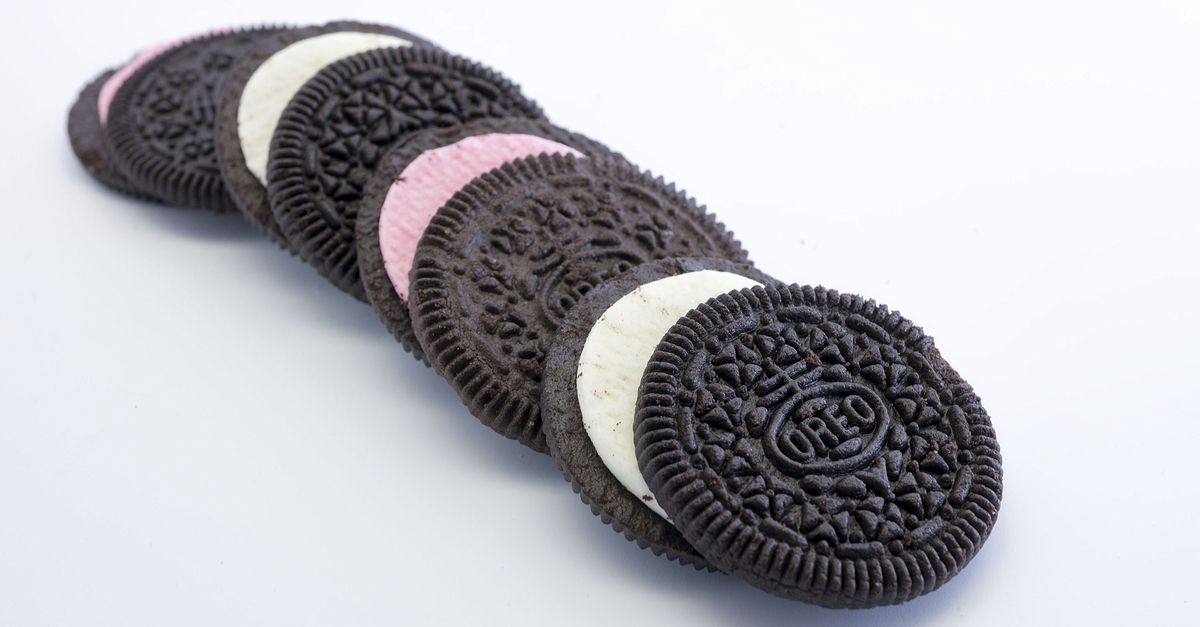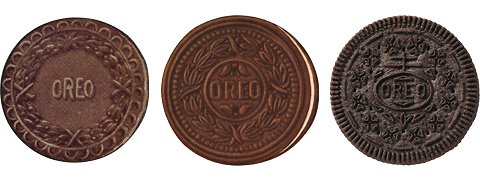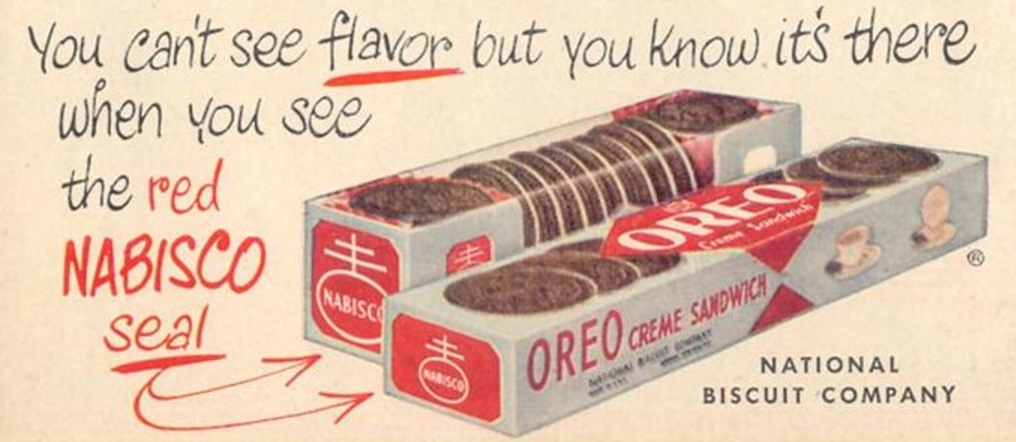We do not know who first paused to ponder the ornate design of an Oreo cookie before eating it, but the decorative embossed pattern is considered integral to the Oreo experience and has inspired praise from such highfalutin sources as American architectural critic Paul Goldberger, who enthused on the occasion of its 75th birthday that the cookie's form "leaps across stylistic boundaries" to epitomize modernism:
The way in which the two chocolate wafers appear to float, held together only by a recessed inner layer of cream filling, seems to epitomize the modernist esthetic, while the richly decorated chocolate wafers are a celebration of the role of ornament. So, like a building that mixes sleek glass and gargoyles, this cookie does nothing less than transcend the gulf separating modernism and traditionalism.
The ornamental pattern of the wafer itself, however, is the Oreo's visual signature. Stamped out by brass rollers passing over sheets of chocolate dough, the pattern consists of a series of four-leaf clovers around the word ''OREO,'' which is set within the traditional trademark of Nabisco, its manufacturer — that trademark being a horizontal oval with what looks like a television antenna extending up from it. Around the clovers, a broken line forms a broken circle. Beyond that, the outer edge of the cookie is slightly ridged, serving both as a visual frame for the ornamental center and as a means of grasping the cookie with comparative ease.
While the cookie-in-itself may not be difficult to grasp, some find that the meaning of its elaborate embossed design nonetheless remains elusive. There is no official explanation of what the ring of four-leaf flowers, the segmented line with intermittent dots encircling it, the television antenna-like structure atop the name "OREO," or the 90 evenly-spaced pillars adorning its outer rim are supposed to stand for (if anything). And despite there being no good reason to assume the pattern is anything other than decorative, there are those for whom the Oreo cookie's design represents a deep, dark mystery to be plumbed. Do the symbols communicate a hidden message?
'Think it's just a coincidence?'
An interesting theory summarized in a 2014 Reddit post links the "symbology" of the Oreo to the medieval Knights Templar and the fraternal order of Freemasonry, two organizations often implicated in grand-scale conspiracy theories:
The symbol around the word Oreo on the center of the cookie was designed from the Knights Templar Cross of Lorraine, which is a symbol of quality. The "flowers" on the Oreo were rendered using the Knights Templar Cross Pattée. The dots, flowers and dashes represent the 3 degrees of Ancient Craft Freemasonry. The arranging of the dots around the cookie were strategically placed to form the 5 Pointed Star; the symbol of the Order of the Eastern Star. All of these symbols are still used throughout the Masonic bodies, including the Eastern Star, Knights Templar and the Scottish Rite.
Think it's just a coincidence?
The inventor, who rapidly climbed from the mail room to design executive and was responsible for today's look of the Oreo, was a Freemason.
There's a lot to unpack there, but we'll forego the factual claims for a moment to address the burning question on the lips of anyone unaccustomed to swimming in the murky waters of conspiracism: So what?
If, in fact, the Oreo's designer was a Freemason, so what? If, in fact, there are esoteric symbols on the cookies, so what? If the presence of those symbols isn't coincidental, what are we supposed to make of that? What's the point of putting them on a cookie?
To be frank, there are probably no rational answers to those questions, nor is it likely that all conspiracy theorists would offer up the same ones. These are folks who claim to find similar symbolism everywhere, including in classical art, popular media, religious texts, corporate logos, and on ordinary currency. They regard such symbols as emblems of a secretive, all-powerful organization — call it Freemasonry, the Order of Solomon's Temple (aka the Knights Templar), the Illuminati, or the New World Order — that has conspired behind the scenes to rule every nation on the planet, like puppet-masters, for centuries. Beyond absolute world domination, it's unclear what the secret society's underlying raison d'être is supposed to be. Some say it's religious (a Jewish or Catholic conspiracy), others say it's occult or Satanic (e.g., a conspiracy to install the Antichrist), others say it's political (e.g., Communism), and still others promote the notion that an evil race of humanoid reptiles is behind it all.
So, why, if it's such a super-secret conspiracy, are graphic symbols of this organization to be found everywhere, including on cookies? The various reasons ventured by conspiracy theorists include the following:
- They're a means of covert communication between members of the Illuminati.
- They're a means of asserting ownership over everything and everyone (essentially a tool of "branding").
- They're a tool of psychic programming or mind control.
- They're a means of luring the unknowing masses into Satanic or occult worship.
- In the case of the cookies specifically, they're a means of tricking untold millions of people to participate in a holy or unholy communion against their will every time they ingest an Oreo.
As you ponder the above, also consider this: Oreos are the largest-selling packaged cookie in the entire world, with $2.9 billion in sales annually in more than 100 different countries. Mondelez International, the parent company of Nabisco, which manufactures Oreos, reports that more than 40 billion of the cookies are baked and consumed every year. Whether it's for the purpose of mind control, covert communication, or mass Satanic conversion, their consumer reach is beyond compare. Indeed, if world domination is one's goal, it's hard to escape the conclusion that Oreos are, in fact, indispensable for that purpose.
Unless, of course, the "symbolism" with which they're embossed is, and always has been, nothing more than a decorative pattern. It's time to take a closer look.
Docked and embossed
The practice of molding or stamping decorative imagery on cookies (or biscuits, as they are also called) is quite old. In its simplest form, a method called "docking," the dough is perforated with small holes to prevent it from puffing during baking. At its most complex, the technique entails "embossing" the surfaces of baked goods with intricate designs for aesthetic or ceremonial purposes. Innovations brought about during the industrial revolution ensured a future in which cookies would be mass-produced by the billions:
The turn of the 19th century saw the birth of the industrial biscuit, and, with it, the marriage of these two morphologies — docking and decorating — into an automated production line. In the late 1890s, two cousins, both called Thomas Vicars, designed the first embossing and cutting machine, capable of punching holes, stamping decorations, and cutting out up to 80 biscuits per minute from a moving sheet of dough. The dies were necessarily hand carved until engraving machines were introduced in the early 1900s. ... But the true golden age of biscuit engineering did not dawn until the invention of the rotary molder in the late 1920s.
This technology, albeit updated with variable speed controls, advanced non-stick coatings, and quality sensors, is still used to make Oreos and most other thick embossed biscuits today. The cookie dough is forced into negative molds, which imprint patterns, brand names, and docker holes. A scraping knife ("D" in the diagram above) scrapes off any excess dough to give a flat bottom, and the formed biscuits peel away onto a conveyor belt to be baked.
In 1908, one of the new industrial-scale baked goods companies created to profit from these rapidly improving production capabilities, Sunshine Biscuits, introduced a product called Hydrox, a creme-filled chocolate sandwich cookie with an embossed design on the top and bottom. It was a sensation, and four years later inspired Sunshine's biggest competitor, the National Biscuit Company (Nabisco), to launch a knock-off: the Oreo (many assume that the Oreo came first and Hydrox was a copycat, but the reverse was true).
Oreo truths
The first thing to know about the Oreo's design, then, is that it was modeled after that of another product, Hydrox, which also had an embossed pattern on its face.
The second thing to know is that the design evolved over time. The pattern we're familiar with today was implemented in 1952, and is a more complex version of the two designs that came before. "Interestingly, when the Oreo was first introduced by Nabisco in 1912," writes Nicola Twilley in The Atlantic, "it used a much more organic wreath for its emboss, later augmented with two pairs of turtledoves in a 1924 redesign."
The third thing to know is that we've established the identity of the person who came up with the current design, a longtime Nabisco engineer named William A. Turnier, and although no one ever had a chance to interview him and inquire as to the meaning of the various elements in the pattern, his son has been quite forthcoming about his father's thinking. Remember the rumor quoted above about the Oreo's designer being a Freemason? Not so, says Bill Turnier of his father, who he claims scoffed when people asked serious questions about the design:
"I read something on the Internet about some speculation about Masonic designs, et cetera," Bill Turnier told me. "But my father was not a Mason. His father was, but he had no big enthusiasm for it. Some of this Masonic stuff, I can't imagine the people who get into that and the numerological significance."
Nonetheless, cookie enthusiasts and numerologists often called his father. "Someone wanted to know the significance of there being 90 notches around the edge," Bill Turnier says. "I think there's 90, and my dad's like, 'I don't know, is that how many there are? I bet I put my compass down and kicked every fourth degree.'"
Bill Turnier recalls that his father also fielded complaints about the four-leafed flower. "Somebody called him up when he was 65 and said there were no flowers with four petals on them. My dad couldn't care." (There are, for the record, plenty of flowers, including the Western Wallflower and varieties of primroses, which bear four petals.)
Turnier's ring of four-petaled flowers was a stylized update of the "more organic" floral patterns used on earlier versions of the cookie. Claiming the shape is actually a version of the "Knights Templar Cross Pattée" does not make it so. Nor does a similarity between the "antenna" shape over the name "OREO" and the traditional Cross of Lorraine (which has also been identified with the Knights Templar in historical imagery) force one to conclude that it had a conspiratorial origin. The oval and cross in the center of the pattern is actually a variant of the Nabisco logo, which, according to the web site of the Bernhardt Fudyma Design Group, has been in use since 1900:
At the end of the 19th century, the newly formed National Biscuit Company took its first step toward the creation of what would become one of the world's most recognized logos. Adolphus Green, the baking giant's first chairman, took charge of developing an entirely new brand-name cracker to be sold in a package specially designed to preserve its crispness. A symbol for this product, and the company itself, was needed for use on the package and in advertising.
Mr. Green found a simple design – an oval crowned by a double-barreled cross – while looking through his collection of rare books. During the 15th century this design was used as a pressmark by the society of Printers in Venice. Prior to that, in the early Christian era, the mark symbolized the triumph of the spiritual over the worldly.
Framed in the octagonal shape of the new 'Uneeda Buiscuit' and filled with the word 'In-er Seal' (the name given to the unique wax-paper-lined package), it became the company's first official trademark in 1900. During the next five decades, the oval enclosed various combinations of the company's initials, the Uneeda brand name and, finally, the current acronym 'Nabisco'.
While the notion that the world's top-selling cookie is somehow a vehicle for powerful secret entities to exercise world domination makes for an exciting story, such evidence as there is suggests that, like so many other staples of modern life, the only real motive behind its invention was the desire to manufacture a good product and sell it at a profit. Sometimes (as Sigmund Freud ought to have said, but didn't), a cookie is just a cookie.




